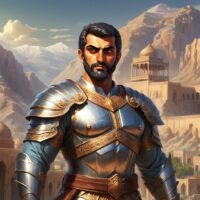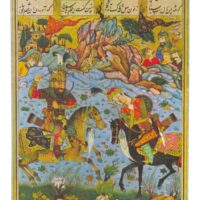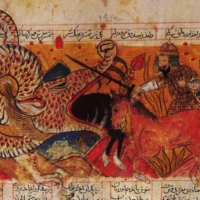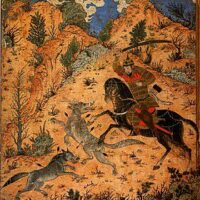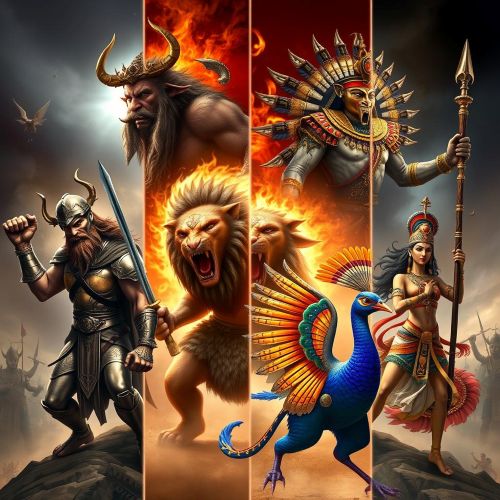Esfandiyar : The Unbeatable Hero
Listen
At a glance
| Description | |
|---|---|
| Origin | Iranian Mythology |
| Classification | Mortals |
| Family Members | Goshtasp (Father), Katayun (Mother) |
| Region | Iran |
| Associated With | Valor, Bravery, Warfare, Nobility |
Esfandiyar
Introduction
Esfandiyar, a legendary hero of Iranian mythology, is a central figure in Ferdowsi’s Shahnameh, an epic composed in the 10th century. A Kayanian prince and divine warrior, he is renowned for his bravery, near-invincibility, and devotion to Zoroastrianism. His tale, marked by themes of heroism, sacrifice, and destiny, culminates in his fateful battle against Rostam, making him one of Persian literature’s most revered figures.
Physical Traits
Esfandiyar is renowned for his incredible strength and bravery, with some accounts describing him as rūyīn-tan (“brazen-bodied”), meaning his skin was impervious to blades. His imposing stature and commanding presence reflect his divine heritage, making him a symbol of heroism in Iranian mythology. Clad in an impenetrable suit of armor, he embodies invincibility, while his noble features and regal demeanor solidify his status as the ideal warrior.
Family
Esfandiyar, a prince of the Kayanian dynasty, was the son of King Goshtasp and Queen Katayun (or Hutaosā, according to some sources). His lineage traced back to the legendary Persian hero Kai Khosrow. Among his siblings were Pašōtan, known for his immortality in Zoroastrian tradition, and several brothers whose numbers vary across accounts. He also had sisters, including Homāy and Behāfarīd. Esfandiyar fathered four sons—Bahman, Mehrnūš, Ṭūš (or Āḏarafrūznūš), and Nūšāḏar (or Āḏarnūš). His family dynamics, particularly his strained relationship with King Goshtasp, played a pivotal role in shaping his fate.
Other names
Esfandiyar’s name appears in various forms, including Esfandyar, Isfandiar, and Isfandiyar, each reflecting different transliterations. His name carries meanings such as “warrior of the faith,” “lion of Persia,” and “champion of righteousness,” while in Persian, it translates to “pure creation.” In the Shahnameh, he is also called Tâjbakhsh, signifying his royal stature. Additionally, he is recognized as a “Zoroastrian Hero” for his devotion to the faith and is sometimes referred to as Shahzadeh, meaning “prince,” emphasizing his noble heritage.
Powers and Abilities
Esfandiyar possessed extraordinary abilities that elevated him above ordinary warriors. His defining trait was near-invincibility, granted by his divine armor, Zereh-e-Esfandiyar, which rendered him impervious to most weapons. It was said that no blade could pierce his body.
A master of combat, he excelled in archery, swordsmanship, and hand-to-hand fighting, demonstrating both brute strength and tactical intelligence. His strategic prowess was evident in his conquest of Dež-e Rūyīn, a fortress thought to be impenetrable. Beyond physical prowess, Esfandiyar had keen perception and an acute sense of danger, honed through experience. His leadership and unwavering commitment to righteousness earned him the admiration of his followers, making him not just a warrior but an emblem of heroism and honor.
Modern Day Influence
Esfandiyar’s legacy remains deeply embedded in modern Iranian culture and beyond. His story continues to be retold in literature, art, and cinema, celebrating him as a national hero and a symbol of resilience against oppression. The Shahnameh itself is regarded as a masterpiece of world literature, influencing countless writers and artists.
His legendary exploits, particularly the Seven Trials of Esfandiyar, are frequently depicted in Persian paintings, showcasing his heroism and struggles. Contemporary artists and poets, such as Esfandiyar Ahmadi, draw inspiration from his character, reflecting his lasting impact on artistic expression. His tale is also a subject of academic research and theatrical performances, underscoring the ongoing engagement with his myth.
Beyond Iran, Esfandiyar is often compared to legendary heroes like Hercules and Achilles, highlighting the universal themes of heroism, sacrifice, and destiny woven into his story. His enduring presence in mythology serves as a testament to the timeless appeal of his character.
Related Images
Source
Ferdowsi, A. (2010). Shahnameh: The Persian Book of Kings. Translated by Dick Davis. Penguin Classics.
Yarshater, E. (2008). Persian Literature. Columbia University Press.
Boyce, M. (2001). Zoroastrians: Their Religious Beliefs and Practices. Routledge.
Davis, D. (1992). Epic and Romance in the Shahnameh of Ferdowsi. University of Chicago Press.
Christensen, A. (1932). Les Types du Premier Homme et du Premier Roi dans l’Histoire Légendaire des Iraniens. E. Leroux.
Aghaie, K. S. (2005). The Martyrs of Karbala: Shi’i Symbols and Rituals in Modern Iran. University of Washington Press.
Encyclopaedia Iranica. Retrieved from
Frequently Asked Questions
What is lorem Ipsum?
I am text block. Click edit button to change this text. Lorem ipsum dolor sit amet, consectetur adipiscing elit. Ut elit tellus, luctus nec ullamcorper mattis, pulvinar dapibus leo.
What is lorem Ipsum?
I am text block. Click edit button to change this text. Lorem ipsum dolor sit amet, consectetur adipiscing elit. Ut elit tellus, luctus nec ullamcorper mattis, pulvinar dapibus leo.
What is lorem Ipsum?
I am text block. Click edit button to change this text. Lorem ipsum dolor sit amet, consectetur adipiscing elit. Ut elit tellus, luctus nec ullamcorper mattis, pulvinar dapibus leo.
What is lorem Ipsum?
I am text block. Click edit button to change this text. Lorem ipsum dolor sit amet, consectetur adipiscing elit. Ut elit tellus, luctus nec ullamcorper mattis, pulvinar dapibus leo.
What is lorem Ipsum?
I am text block. Click edit button to change this text. Lorem ipsum dolor sit amet, consectetur adipiscing elit. Ut elit tellus, luctus nec ullamcorper mattis, pulvinar dapibus leo.

